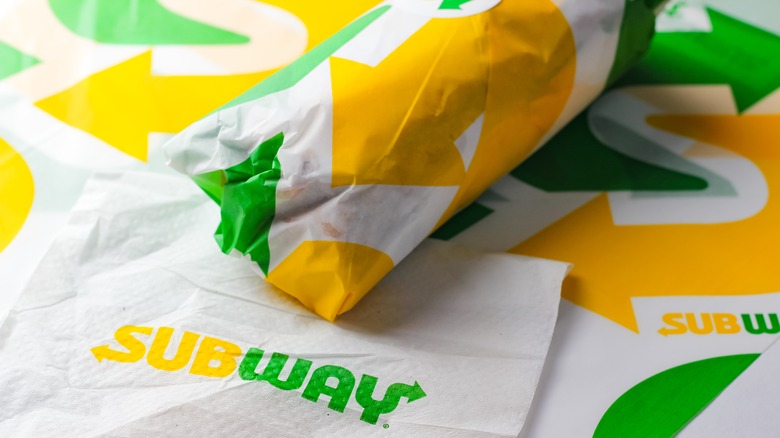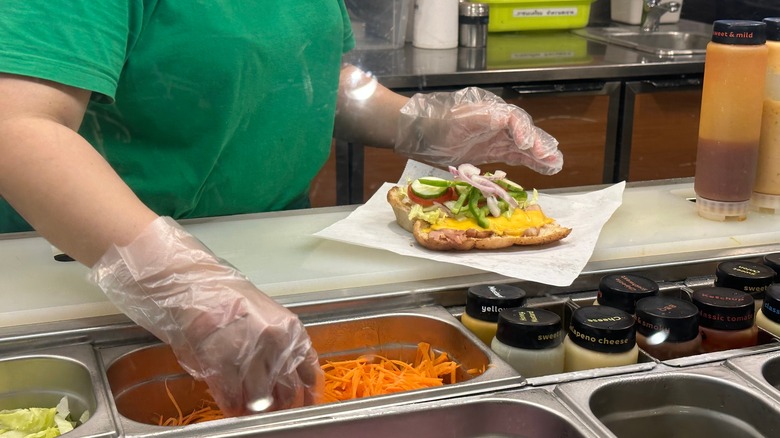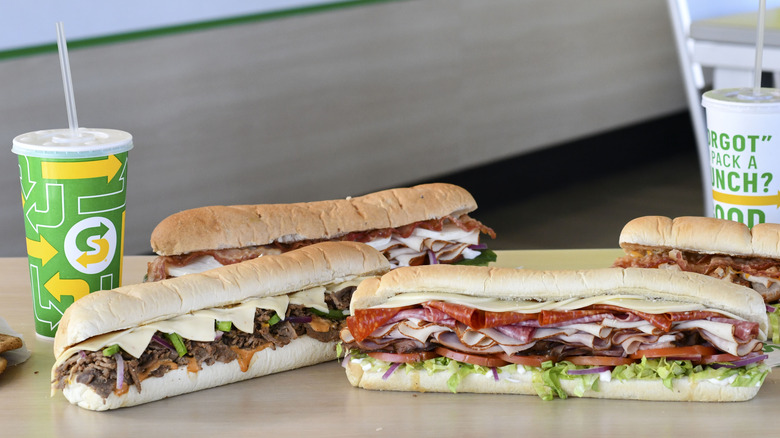The Distinctive Way Subway Used To Cut Its Subs
Before the national sub landscape was also occupied by chains like Firehouse Subs and Jersey Mike's, Subway ruled. The first Subway location opened in 1965, and it hasn't strayed from its original mission of serving sandwiches — probably smart, given Subway's recent business troubles. However, Subway, like all chains, attempts innovations to keep with the times and lower operating costs. Subway even changed the way it cuts its iconic sandwiches, to the dismay of longtime sub fans.
From when Subway first debuted all the way through the late nineties, sandwich artists would cut the top off the bread for your customized sandwich. Known to Subway employees as a U-Gouge or informally, as a V-Cut, this method of slicing bread created a channel to keep all those meats and toppings in place. As customers asked for more and more fillings in their sandwiches, Subway pivoted to a cut that enabled the bread to be opened wider. Decades after the update, the company still defends the decision to abandon the old method, taking to X (then Twitter) in 2016 to proclaim, "Our current hinge cut is better for allowing you to pile on the ingredients you want."
While there doesn't appear to be an announcement related to exactly when Subway retired the U-Gouge, Redditors report that the phaseout may have begun in the late '90s. Alas, this means modern-day workers aren't going to know what the customer means if they request their bread to be sliced in the old style. So, no trendy TikTok hack here, but rather a lesson in how the smallest measures in fast food can help create efficiencies in the day-to-day biz.
Why Subway stopped using the V-Cut
According to Redditors, the U-Gouge method of slicing Subway's bread took a lot of practice to get right. Incorrect cuts led to wasted bread, lest Subway serve a sub with a too-small bread lid, or with too-deep a gouge penetrating the larger bottom piece. In the fast food business, every second counts, and the shift to the simpler hinge cut made sense as it shaved time off each order. Additionally, this cutting technique could put sandwich artists' hands in danger. Accounts from former Subway employees on Reddit conflict on whether the U-Gouge required employees to turn the bread knife towards them, or to rotate the bread itself. Regardless, it required use of a sharper knife than the hinge cut, which led to some sandwich artists accidentally cutting themselves while slicing.
The final straw for the V-Cut, though, was Subway's decision to yield to public perception of their sandwich fillings. Subway market research uncovered that people believed their sandwich had more toppings if those toppings were spilling out of it. The hinge cut let the fillings loose, and users were satisfied; further customer polling revealed that they overwhelmingly preferred the hinge cut sandwich, as it was easier to hold.
The minority in favor of making the U-Gouge the standard one is vocal, and you can even join them by signing a petition asking that Subway return to the old style, but really all you have to do is ask (and possibly explain what it is to sandwich artists out of the know).
Subway's many bread controversies, explained
The disappearance of the V-Cut isn't the only fracas Subway has been involved with regarding its bread. In 2013, disgruntled Subway customers filed a suite of class action lawsuits against the company, claiming that its famous Footlong subs were not, in fact, a foot long. While Subway implemented quality control measures after an Australian teenager's claim that his sandwich was 11 inches long went viral, in 2016, a Wisconsin federal court held the chain to the standards claimed, however, the class action settlement was later thrown out on appeal in 2017.
In 2014, a blog known as Food Babe posted an online petition imploring Subway remove a chemical compound called azodicarbonamide from its bread, citing that it's also used to make yoga mats and could pose cancer risks. The restaurant quickly complied and reported that the chemical would be completely gone from its bread by April of that year. Researchers at the Environmental Working Group subsequently published a report noting that nearly 500 food products contained the unnecessary chemical.
And in late 2020, the Irish Supreme Court ruled that Subway's bread had excessive sugar content, meaning that Ireland couldn't technically define it as bread. Subway immediately went on the defensive against the ruling that Subway bread is closer to a pastry, issuing a statement to the Guardian saying, "Subway's bread is, of course, bread."


